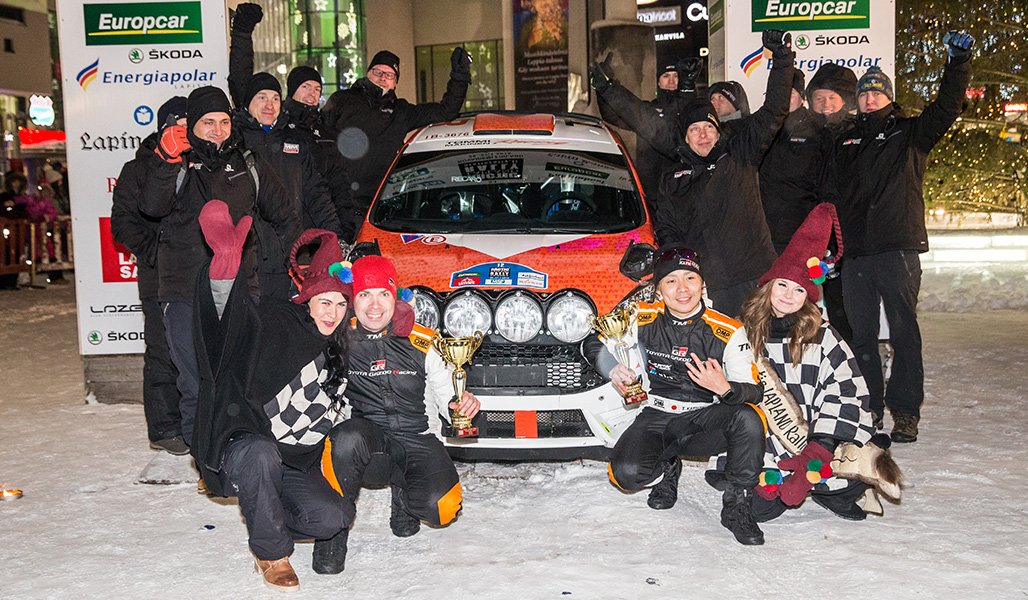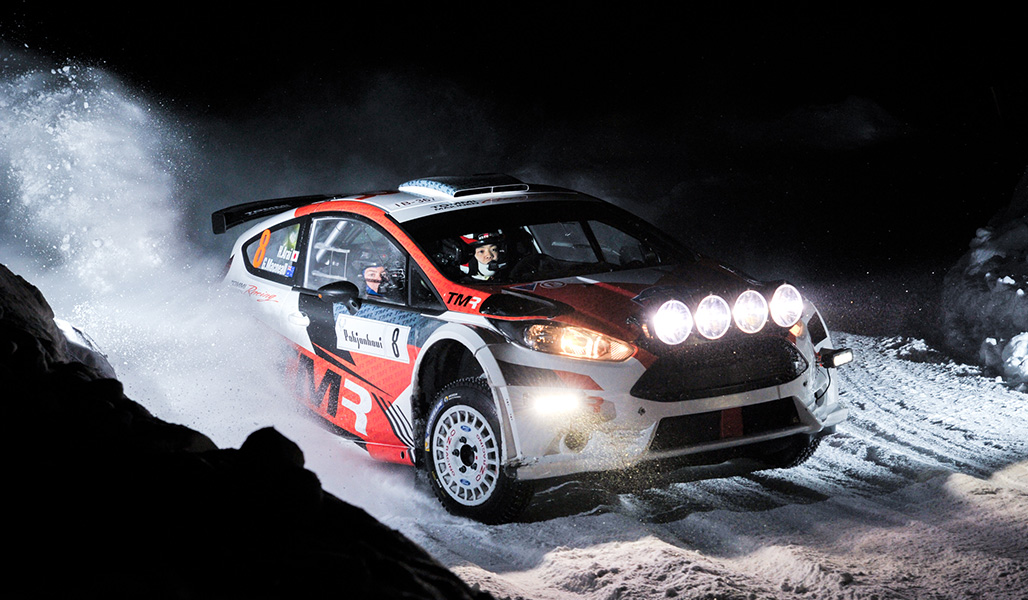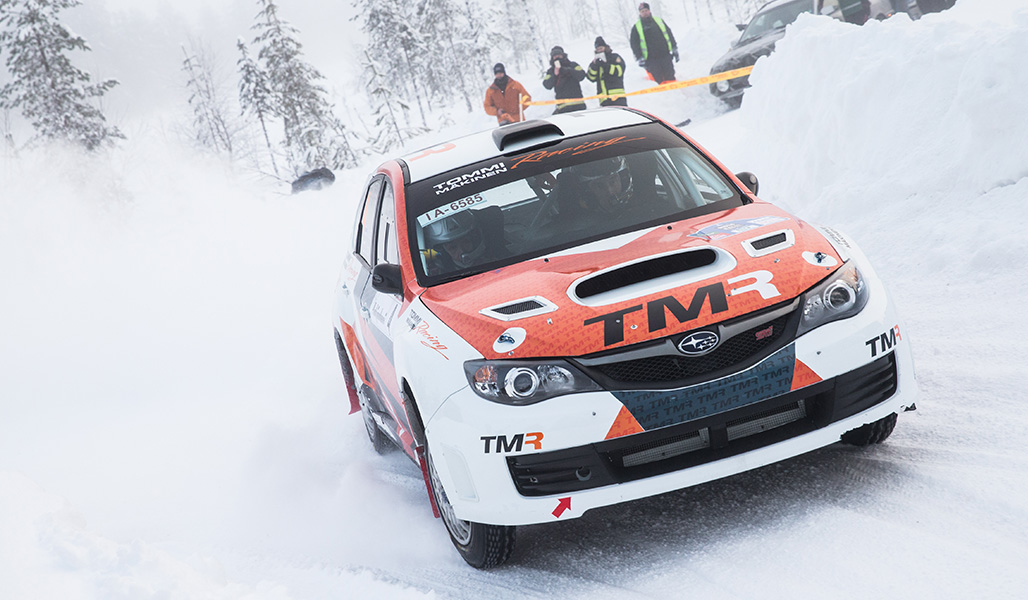TOYOTA GAZOO Racing Rally Challenge Program returns for 2018 with a podium on the Arctic Rally
The TOYOTA GAZOO Racing Rally Challenge Program is back for 2018, with the same participants as last year, and it started in sub-zero temperatures last weekend on the Arctic Rally in Northern Finland. Young Japanese talents Takamoto Katsuta and Hiroki Arai finished third and 12th respectively in their R5 cars, while Japanese co-driver Sayaka Adachi returned alongside Finnish star Jarkko Nikara, finishing seventh in an R4 based car.
The famous Arctic Rally is held entirely on snow and is probably the coldest rally in the world, with temperatures dipping close to minus 30 degrees centigrade. The 11 stages are fast and flowing, with the cars using studded tyres to bite into the slippery surface and find grip. Commitment and accuracy of pace notes is key to success on the rapid stages. Some of motorsport’s top stars have taken part in the Arctic Rally in the past, including Formula 1 champions, and this year a total of 18 top R5 cars meant that there was stronger competition than ever.
Katsuta, co-driven by Marko Salminen from Finland, was tackling the rally for the third time: just like his team mate Arai. Katsuta got off to a good start in his new R5 car, proving that he had consistency as well as pace, with a clean run from start to finish. He saved his biggest push for the long final stage, where he was third-fastest to seal a podium place on what was probably his best overall performance to date.
Sayaka Adachi, co-driving for Jarkko Nikara, was competing on the Arctic Rally for only the second time, while her driver had plenty of experience of the snowy event. They got off to a good start but hit a tree at the end of SS2 and picked up damage, which meant that the car was then late leaving service as the damage was fixed. On Friday afternoon, they lost power steering on one of the longest stages, meaning that Nikara had to drive for around 30 kilometres with no steering assistance.
Hiroki Arai and his Australian co-driver Glenn Macneall hit problems on SS2 when they got stuck in one of the many snowbanks for around two minutes. From then on, they had to play catch-up, demonstrating their speed with a second-fastest time on SS7. However, they were also slowed by a technical problem in the closing stages of the rally, which cost them more time.
Hiroki Arai
“It’s been really exciting to get back in the car again. I tried to simplify my pace notes, to help me relax more in the stage and focus on the important details: this definitely helped. Unfortunately, we went off on the first day and then had a technical problem in the final part of the rally, which also cost us time. But the most important thing was that we showed good pace. In the end, I think we had more positives than negatives and it was useful preparation for Rally Sweden.”
Sayaka Adachi
“It was good that we had a long recce for Arctic Rally because it meant that I had lots of opportunities to practise my pace notes. This year we are making a small change and using a few more Finnish words in the notes, as they are a bit easier for Jarkko to understand. Most of the stages on the Arctic Rally were run the opposite way this year and one was completely new, but my experience from the year before was really valuable and it felt easier for me than last time. Although I am still learning, generally I was quite happy with my reading of the pace notes on this rally. Now I want to make use of this experience to try again on the next rally.”
Jarkko Nikara
“With our car up against so many fast R5 cars I didn’t really think we had the chance to win, but this was even tougher than I expected. The collaboration with Sayaka is working well. There was just one stage, SS7, when she was actually faster than me, so we got a bit confused for about one kilometre or so. But apart from that there were no issues and the progress was really good: you can see how the past experience helps.”
Jouni Ampuja (TOYOTA GAZOO Racing Rally Challenge Program instructor)
“The Arctic Rally allowed plenty of recce and that was useful as our crews have all made changes to their pace note systems. For our young Japanese drivers, they are beginning to get some experience under their belts so of course we would like to see them take another step up this year in terms of results and performance. We can see that this has already started on the Arctic Rally. To achieve the level of consistency that Takamoto did, at these speeds is really not easy. Sayaka too has definitely made another improvement. The more you learn the more you discover. Now we go to Rally Sweden, and I look forward to seeing all our crews put into practice what they have learned here.”
Results:
1 Eerik Pietarinen/Juhana Raitanen (Skoda Fabia R5) 2h08m49.3s
2 Emil Lindholm/Mikael Korhonen (Skoda Fabia R5) +2m25.4s
3 Takamoto Katsuta/Marko Salminen (Ford Fiesta R5) +2m36.2s
4 Jukka Ketomaki/Jarkko Alanen (Skoda Fabia R5) +2m41.9s
5 Marko Mänty/Joni Mäkelä (Skoda Fabia R5) +3m09.3s
- - - - - - - - - - - -
7 Jarkko Nikara/Sayaka Adachi (Subaru Impreza WRX STI) +4m07.5s
12 Hiroki Arai/Glenn Macneall (Ford Fiesta R5) +8m54.7s
What’s next?:
Next up for all three crews is Rally Sweden from February 9-12, round two of the World Rally Championship. Like the Arctic Rally, it’s run on rapid snow and ice stages in chilly weather . All three crews will drive R5 cars, which means a step up in performance for Nikara and Adachi.





Quotes:
Takamoto Katsuta
“I am very happy with this result, which is maybe the best performance I have ever done. The biggest change we made since last year is altering the angle scale of our pace notes: this means that the instructions are more simple and clear, and the recce is easier too. My aim was to drive between 80 and 90 per cent on most of the rally, push where I felt confident, but keep enough back to have a consistent pace and most importantly of all, get to the finish. I think we achieved that. Of course, we still have a lot to learn and improve on, but I think we are going in the right direction.”